The Impact of an Electrical Mini-grid on the Development of a Rural Community in Kenya
Abstract
1. Introduction
1.1. Mini-grids in the Context of Electrification Research
1.2. Country Context and Site Selection
1.2.1. Site Selection
1.2.2. Site characteristics
2. Materials and Methods
2.1. Household Level
- What is your household expenditure?
- What is your expenditure on kerosene?
- On a set of steps representing wealth from 1–10 (poorest to richest), on which step would you be today?
- How many pieces of fruit do you eat on a typical day?
- Does your household have access to electricity? (from rechargeable battery up to grid)
2.2. Business Level
- When did you open your business? (year, month)
- What is your daily expenditure and income?
- What are your opening hours?
- What proportion of your customers come from outside the trading centre?
2.3. Community Level
2.4. Mini-Grid Level
2.4.1. Community-Based Operation and Governance
2.4.2. Design of the Solar Photovoltaics Power System
3. Results and Discussion
3.1. Household-Level Results
3.1.1. Household Expenditure and Perceived Financial Wellbeing
3.1.2. Nutrition
3.1.3. Access to Electricity
3.2. Trading Centre-Level Results
3.3. Community-Level Results
3.3.1. Education
3.3.2. Healthcare
3.4. Mini-Grid Operation
3.4.1. Community-Based Operation and Governance
3.4.2. Design of the Solar Photovoltaics Power System
3.4.3. Business Model
4. Conclusions
Supplementary Materials
Author Contributions
Funding
Acknowledgments
Conflicts of Interest
Appendix A
| Variable | Criteria | Reason |
|---|---|---|
| Population density | P > 50 people/km2 | Avoid areas that have transient, semi-nomadic populations |
| Distance from grid or existing decentralized power system to centroid of sub-location | D > 5 km | Avoid areas where grid connection or infilling is highly likely in the future a |
| Population density-distance product | P.D > 1000 | Select areas with significant population density but nevertheless far from the existing network |
| Surrounding constituency indicated as soon to be fully electrified in the 2009 Rural Electrification Masterplan? | No | Avoid areas slated for imminent investment in grid extension or decentralized power system |
| District | Number of Selected Sub-Locations | Population of Selected Sub-Locations | Land Area of Selected Sub-Locations (km2) | Average Population Density of Selected Areas (people/km2) | Indicated in REM as Fully Electrified? |
|---|---|---|---|---|---|
| Makueni | 16 | 38264 | 510 | 75 | No |
| Kitui | 7 | 31893 | 464 | 69 | No |
| Migori | 10 | 24353 | 86 | 282 | No |
| Butere/Mumias | 2 | 11513 | 32 | 364 | No |
Appendix B
| Category | Benefits/Drawbacks |
|---|---|
| Security | PV panels and cabling are more difficult to steal and/or vandalize as the access ladder is normally locked in the plant room. In addition, the risk of accidental damage by people or animals (by digging, throwing objects, etc.) is reduced. |
| Shading | Raising the panels up reduces risk of shading from trees, buildings and other obstructions, which could otherwise result in loss of performance of the array. |
| Rainwater | In a semi-arid area, water is a valuable commodity. Rainwater is stored in two 10000 litre tanks and sold by the co-operative for 10 KES per 20 litre container. |
| Land use | By housing the plant room and manager’s office underneath the canopy, the total amount of land taken by the facility is minimized. This helps in locations where land ownership is a sensitive issue, such as Kenya. |
| Shelter | The canopy provides a shaded area used for community meetings. Previously, meetings were held in the open, with limited shade from a tree. Additionally, the canopy shades the plant room, reducing the temperature of the electrical equipment. |
| Rain splash | Ground mounted panels would be likely to be exposed to soil thrown up by heavy rain from bare earth surfaces. |
| Cleaning | Cleaning requires someone to climb up a ladder onto the canopy and clean with a long-handled brush. As the panels are not visible, they are ‘out of sight out of mind’ to a certain extent. Dirty panels would be more obvious and cleaning would be easier and safer on the ground, however risk is minimised by a walkway set into the canopy at a safe distance from the edge. The canopy has sufficient slope that it will self-clean during the rainy seasons. |
| Cost | The canopy and rainwater tanks added 17% to the capital investment requirement for the mini-grid, which is discussed in Section 3.4. |
Appendix C
| Day | November | December | January | February | March | April | May | June | July | August | September | October |
|---|---|---|---|---|---|---|---|---|---|---|---|---|
| 01 | 11.12 | 12.33 | 13.06 | 11.81 | 11.65 | 11.87 | 11.21 | 12.89 | 12.58 | 12.76 | 12.56 | 12.83 |
| 02 | 9.97 | 12.01 | 10.88 | 12.52 | 11.90 | 11.93 | 10.92 | 11.72 | 12.78 | 10.90 | 13.05 | 12.95 |
| 03 | 11.29 | 11.15 | 11.66 | 12.52 | 12.15 | 11.76 | 11.18 | 12.91 | 12.54 | 12.09 | 13.01 | 12.19 |
| 04 | 10.13 | 11.10 | 10.91 | 12.10 | 12.44 | 12.21 | 12.37 | 13.13 | 13.69 | 12.44 | 13.30 | 11.79 |
| 05 | 10.96 | 11.86 | 12.75 | 12.70 | 13.36 | 11.40 | 12.99 | 13.31 | 14.06 | 12.31 | 13.13 | 12.30 |
| 06 | 11.29 | 11.04 | 11.90 | 11.89 | 13.60 | 12.53 | 12.11 | 12.44 | 13.78 | 12.39 | 11.60 | 12.82 |
| 07 | 10.39 | 10.87 | 12.31 | 11.71 | 13.08 | 12.43 | 11.73 | 12.45 | 14.27 | 13.01 | 12.29 | 12.63 |
| 08 | 10.95 | 11.23 | 12.19 | 11.63 | 12.66 | 12.58 | 12.39 | 12.10 | 14.65 | 12.98 | 13.65 | 13.29 |
| 09 | 10.45 | 11.06 | 11.92 | 12.78 | 12.46 | 12.11 | 12.56 | 12.68 | 15.16 | 11.76 | 12.66 | 13.16 |
| 10 | 11.00 | 12.26 | 12.04 | 13.68 | 12.77 | 11.90 | 12.90 | 12.44 | 13.47 | 12.33 | 12.94 | 13.20 |
| 11 | 10.47 | 11.24 | 12.67 | 12.59 | 12.39 | 12.35 | 12.92 | 12.59 | 14.83 | 13.50 | 13.32 | 11.66 |
| 12 | 10.28 | 11.55 | 12.00 | 13.28 | 12.58 | 11.24 | 13.01 | 13.07 | 12.64 | 12.60 | 13.56 | 12.59 |
| 13 | 10.65 | 11.60 | 11.78 | 11.78 | 11.55 | 11.39 | 12.88 | 13.53 | 12.49 | 11.74 | 11.92 | 13.53 |
| 14 | 11.20 | 12.19 | 11.05 | 12.21 | 11.66 | 12.09 | 12.20 | 12.69 | 13.29 | 12.97 | 13.18 | 13.43 |
| 15 | 11.50 | 12.77 | 12.02 | 11.62 | 12.03 | 11.98 | 11.94 | 12.48 | 13.73 | 12.33 | 13.68 | 13.18 |
| 16 | 11.61 | 11.72 | 12.14 | 13.35 | 12.68 | 12.10 | 11.72 | 13.76 | 12.81 | 11.65 | 13.31 | 13.64 |
| 17 | 10.67 | 11.43 | 13.11 | 13.68 | 11.74 | 12.25 | 12.01 | 13.71 | 13.26 | 12.26 | 13.94 | 14.60 |
| 18 | 11.16 | 11.37 | 12.29 | 12.89 | 12.76 | 11.78 | 12.14 | 14.81 | 13.17 | 12.79 | 13.41 | 12.70 |
| 19 | 10.86 | 11.36 | 11.92 | 14.49 | 13.08 | 11.53 | 12.32 | 14.53 | 11.98 | 12.99 | 13.22 | 13.67 |
| 20 | 10.42 | 12.24 | 12.12 | 11.37 | 12.35 | 12.59 | 12.65 | 13.13 | 11.84 | 13.30 | 12.26 | 13.36 |
| 21 | 10.23 | 11.34 | 11.68 | 13.11 | 12.79 | 12.14 | 13.72 | 12.67 | 12.97 | 12.97 | 13.31 | 14.36 |
| 22 | 10.98 | 13.59 | 11.89 | 12.63 | 11.99 | 12.08 | 12.55 | 14.14 | 13.60 | 12.99 | 14.83 | 13.80 |
| 23 | 10.76 | 12.11 | 11.61 | 12.73 | 11.95 | 12.70 | 12.65 | 14.17 | 13.09 | 13.06 | 13.51 | 13.47 |
| 24 | 11.10 | 13.39 | 11.63 | 11.97 | 12.28 | 12.24 | 12.41 | 13.82 | 13.15 | 12.60 | 13.08 | 13.52 |
| 25 | 11.40 | 14.36 | 11.05 | 13.82 | 13.04 | 13.08 | 12.51 | 13.09 | 12.92 | 12.81 | 13.34 | 13.39 |
| 26 | 11.19 | 12.29 | 11.14 | 14.05 | 12.50 | 11.84 | 13.41 | 12.04 | 11.96 | 12.38 | 13.05 | 13.55 |
| 27 | 12.27 | 12.04 | 11.81 | 13.15 | 11.89 | 13.01 | 13.76 | 13.72 | 12.34 | 13.31 | 12.31 | 13.36 |
| 28 | 10.87 | 11.58 | 12.39 | 12.51 | 12.27 | 12.15 | 12.21 | 12.76 | 12.87 | 12.92 | 13.59 | 12.88 |
| 29 | 12.21 | 13.22 | 11.24 | 11.88 | 12.31 | 12.53 | 12.91 | 12.29 | 12.29 | 13.40 | 13.00 | |
| 30 | 11.12 | 12.05 | 12.77 | 12.15 | 11.78 | 12.71 | 13.04 | 12.61 | 12.08 | 12.97 | 13.78 | |
| 31 | 12.88 | 13.31 | 12.42 | 12.65 | 13.95 | 12.49 | 14.04 |
References
- International Energy Agency. World Energy Outlook Energy Access Database. 2017. Available online: http://www.worldenergyoutlook.org/resources/energydevelopment/energyaccessdatabase/ (accessed on 13 January 2019).
- Adair-Rohani, H.; Zukor, K.; Bonjour, S.; Wilburn, S.; Kuesel, A.C.; Hebert, R.; Fletcher, E.R. Limited electricity access in health facilities of sub-Saharan Africa: A systematic review of data on electricity access, sources, and reliability. Glob. Health Sci. Pract. 2013, 1, 249–261. [Google Scholar] [CrossRef] [PubMed]
- United Nations. Sustainable Development Goals. 2015. Available online: http://www.un.org/sustainabledevelopment/sustainable-development-goals (accessed on 13 January 2019).
- Modi, V.; McDade, S.; Lallement, D.; Saghir, J. Energy and the Millennium Development Goals; Energy Sector Management Assistance Programme; United Nations Development Programme, UN Millennium Project, and World Bank: New York, NY, USA, 2006. [Google Scholar]
- Sustainable Energy for All. Our Mission. 2017. Available online: http://www.se4all.org/our-mission, (accessed on 13 January 2019).
- Szabó, S.; Bódis, K.; Huld, T.; Moner-Girona, M. Energy solutions in rural Africa: Mapping electrification costs of distributed solar and diesel generation versus grid extension. Environ. Res. Lett. 2011, 6, 34002. [Google Scholar] [CrossRef]
- Chaurey, A.; Krithika, P.R.; Palit, D.; Rakesh, S.; Sovacool, B.K. New partnerships and business models for facilitating energy access. Energy Policy 2012, 47, 48–55. [Google Scholar] [CrossRef]
- Tenenbaum, B.; Greacen, C.; Siyambalapitiya, T.; Knuckles, J. Regulatory Decisions for Small Power Producers Serving Retail Customers: Tariffs and Quality of Service. From the Bottom Up: How Small Power Producers and Mini-Grids Can Deliver Electrification and Renewable Energy in Africa, Directions in Development—Energy and Mining; The World Bank: Washington, DC, USA, 2014; pp. 239–281. [Google Scholar] [CrossRef]
- Beyond Connections: Energy access Redefined; ESMAP Technical Report 008/15; World Bank: Washington, DC, USA, 2015; Available online: https://www.esmap.org/node/55526 (accessed on 13 January 2019).
- Aklin, M.; Bayer, P.; Harish, S.P.; Urpelainen, J. Does basic energy access generate socioeconomic benefits? A field experiment with off-grid solar power in India. Sci. Adv. 2017, 3, e1602153. [Google Scholar] [CrossRef] [PubMed]
- Lenz, L.; Munyehirwe, A.; Peters, J.; Sievert, M. Does Large-Scale Infrastructure Investment Alleviate Poverty? Impacts of Rwanda’s Electricity Access Roll-Out Program. World Dev. 2017, 89, 88–110. [Google Scholar] [CrossRef]
- Knuckles, J. Business models for mini-grid electricity in base of the pyramid markets. Energy Sustain. Dev. 2016, 31, 67–82. [Google Scholar] [CrossRef]
- Bhattacharyya, S.C.; Palit, D. Mini-Grids for Rural Electrification of Developing Countries: Analysis and Case Studies from South Asia; Springer: Cham, Switzerland, 2014. [Google Scholar]
- Bhattacharyya, S.C.; Palit, D. Mini-grid based off-grid electrification to enhance electricity access in developing countries: What policies may be required? Energy Policy 2016, 94, 166–178. [Google Scholar] [CrossRef]
- Access to Modern Energy Services for Health Facilities in Resource-Constrained Settings: A Review of Status, Significance, Challenges; World Health Organization: Geneva, Switzerland, 2014; Available online: http://www.who.int/iris/handle/10665/156847 (accessed on 13 January 2019).
- Increasing access to Health Workers in Remote and Rural Areas through Improved Retention; World Health Organization: Geneva, Switzerland, 2010; Available online: http://www.who.int/hrh/retention/guidelines/en/ (accessed on 13 January 2019).
- Khandker, S.R.; Samad, H.A.; Ali, R.; Barnes, D.F. Who Benefits Most from Rural Electrification? Evidence in India; Policy Research Working Papers; The World Bank: Washington, DC, USA, 2012. [Google Scholar] [CrossRef]
- Legros, G.; Rijal, K.; Seyedi, B. Decentralized Energy Access and the Millennium Development Goals; Government of Nepal and UN Development Programme: Rugby, UK, 2012; Available online: http://www.np.undp.org/content/nepal/en/home/library/environment_energy/decentralized-energy-access-and-the-millennium-development-goals/ (accessed on 13 January 2019).
- Kirubi, C.; Jacobson, A.; Kammen, D.M.; Mills, A. Community-Based Electric Micro-Grids Can Contribute to Rural Development: Evidence from Kenya. World Dev. 2009, 37, 1208–1221. [Google Scholar] [CrossRef]
- Kenya National Bureau of Statistics—KNBS; National AIDS Control Council/Kenya; National AIDS/STD Control Programme/Kenya; Ministry of Public Health and Sanitation/Kenya; Kenya Medical Research Institute. Kenya Demographic and Health Survey 2008-09; KNBS and ICF Macro: Calverton, MD, USA, 2010; Available online: http://dhsprogram.com/pubs/pdf/FR229/FR229.pdf (accessed on 13 January 2019).
- Sustainable Energy for All. Urban/Rural Divide. 2014. Available online: https://www.seforall.org/heatmaps/electrification/divide (accessed on 13 January 2019).
- Kenya Power and Lighting Company. Kenya Power Annual Report and Financial Statements for the year ended 30 June 2017. November 2017. Available online: http://kplc.co.ke/AR2017/KPLC%202016%20-%202017%20Annual%20Report-.pdf (accessed on 13 January 2019).
- Adan, J. Kenya Power new connections charge lowered to Sh15,000. Business Daily. 27 May 2015. Available online: https://www.businessdailyafrica.com/news/Kenya-Power-connections-lowered-to-Sh15-000/539546-2731146-c4g8u/index.html (accessed on 13 January 2019).
- Njono, K.S. Pulling Apart or Pooling Together? Exploring Kenya’s Inequality; Kenya National Bureau of Statistics and Society for International Development: Nairobi, Kenya, 2013; Available online: http://inequalities.sidint.net/kenya/abridged/consumption-expenditure/ (accessed on 13 January 2019).
- Kenya Power and Lighting Company. Last Mile Connectivity. 2017. Available online: http://www.kplc.co.ke/content/item/1120/last-mile-connectivity (accessed on 13 January 2019).
- David, H.; Otuki, N. Longer wait for cheaper Sh15,000 power connection. Daily Nation. 21 February 2017. Available online: https://www.nation.co.ke/business/Longer-wait-for-cheaper-Sh15-000-power-connection/996-3821722-hx3u6s/index.html (accessed on 13 January 2019).
- Kenya Power and Lighting Company. Power Interruptions. Available online: http://kplc.co.ke/category/view/50/power-interruptions (accessed on 13 January 2019).
- Enterprise Surveys: Kenya Country Profile 2013. World Bank. Available online: http://www.enterprisesurveys.org/~/media/GIAWB/EnterpriseSurveys/Documents/CountryHighlights/Kenya-2013.pdf (accessed on 13 January 2019).
- Rural Electrification Masterplan; Final Report; Kenya Ministry of Energy and Kenya Rural Electrification Authority: Nairobi, Kenya, 2009; Volume 1.
- Essendi, H.; Nyovani, M.; Matthews, Z. Perceptions of development by residents of a rural community in Kenya: A capability issue. J. Afr. Stud. Dev. 2014, 6, 67–77. [Google Scholar] [CrossRef]
- Essendi, H.; Amoako Johnson, F.; Madise, N.; Matthews, Z.; Falkingham, J.; Bahaj, A.; James, P.; Blunden, L. Infrastructural challenges to better health in maternity facilities in rural Kenya: Community and health worker perceptions. Reprod. Health 2015, 12, 1–11. [Google Scholar] [CrossRef] [PubMed]
- Gichuki, F.; Mbogoh, S.; Tiffen, M.; Mortimore, M. Makueni District Profile: Synthesis; Drylands Research Working Paper No. 11; Drylands Research: Crewkerne, UK, 2000. [Google Scholar]
- Gertler, P.J.; Martinez, S.; Premand, P.; Rawlings, L.B.; Vermeersch, C.M.J. Impact Evaluation in Practice, 2nd ed.; Inter-American Development Bank and World Bank: Washington, DC, USA, 2016. [Google Scholar]
- Erin, C.; Strumpf, E.C.; Harper, S.; Kaufman, J.S. Fixed Effects and Difference-in-Differences. In Methods in Social Epidemiology, 2nd ed.; Oakes, J.M., Kaufman, J.S., Eds.; Jossey-Bass: San Francisco, CA, USA, 2017; pp. 341–365. [Google Scholar]
- Dasso, R.; Fernandez, F. The effects of electrification on employment in rural Peru. IZA J. Labor Dev. 2015, 4, 1–16. [Google Scholar] [CrossRef]
- George, G.; Kotha, R.; Parikh, P.; Alnuaimi, T.; Bahaj, A.S. Social structure, reasonable gain, and entrepreneurship in Africa. Strat. Manag. J. 2016, 37, 1118–1131. [Google Scholar] [CrossRef]
- Vernet, A.; Khayesi, J.N.O.; George, V.; George, G.; Bahaj, A.S. How does energy matter? Rural electrification, entrepreneurship, and community development in Kenya. Energy Policy 2019, 126, 88–98. [Google Scholar] [CrossRef]
- Kwakyewah, C. Rethinking the Role of Cooperatives in African Development. Inq. J. 2016, 8. Available online: http://www.inquiriesjournal.com/a?id=1419 (accessed on 13 January 2019).
- Benchmarking Study of Solar PV Mini Grids Investment Costs: Preliminary Results; Energy Sector Management Assistance Program (ESMAP). World Bank Group: Washington, DC, USA, 2017; p. 8. Available online: http://documents.worldbank.org/curated/en/569621512389752401/Benchmarking-study-of-Solar-PV-mini-grids-investment-costs-preliminary-results (accessed on 13 January 2019).
- Energy for Development Network. Current Projects. Available online: http://www.energyfordevelopment.net/current-projects/ (accessed on 13 January 2019).
- Kenya Power and Lighting Company. Know your Bill. 2014. Available online: http://kplc.co.ke/knowyourbill/ (accessed on 13 January 2019).

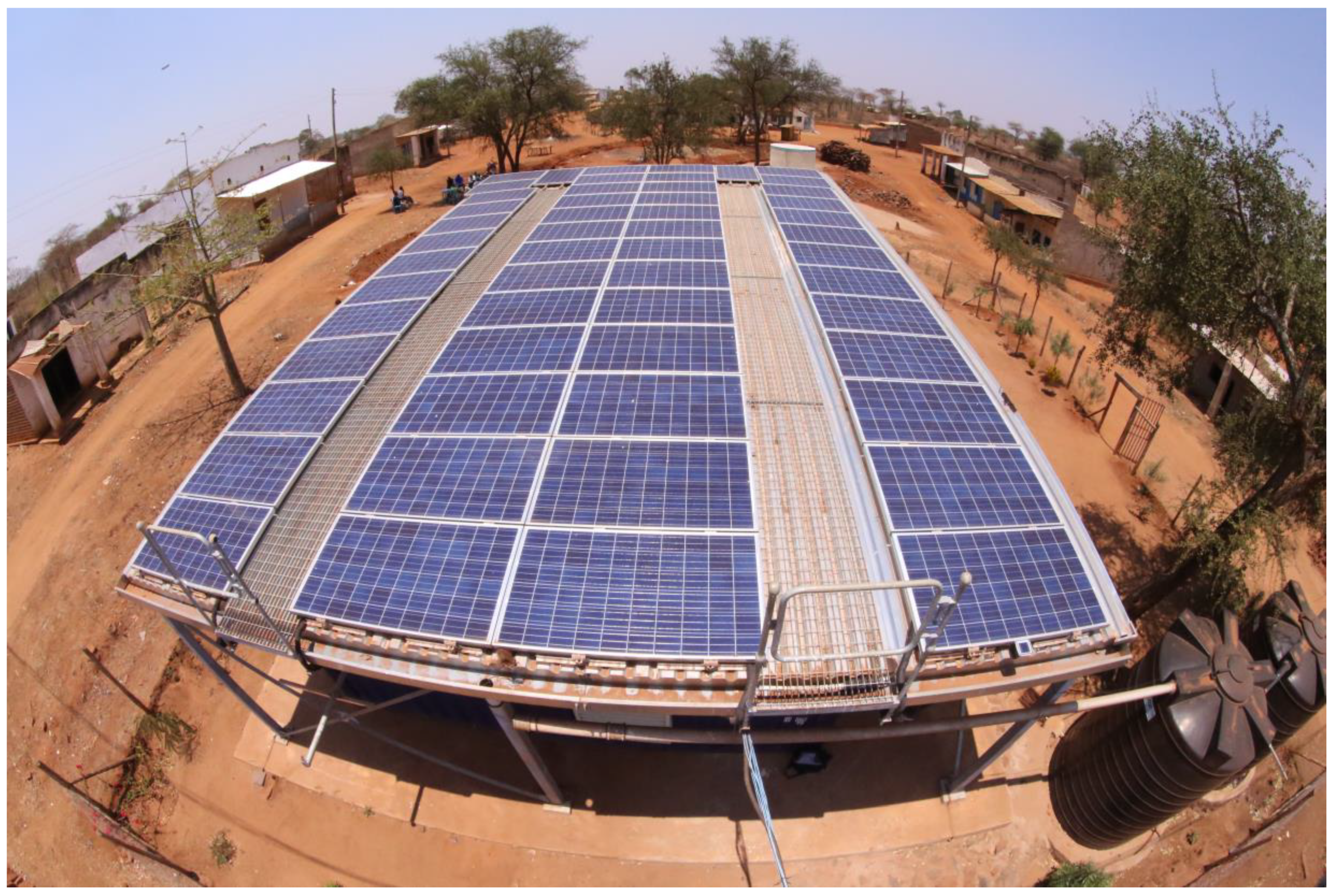


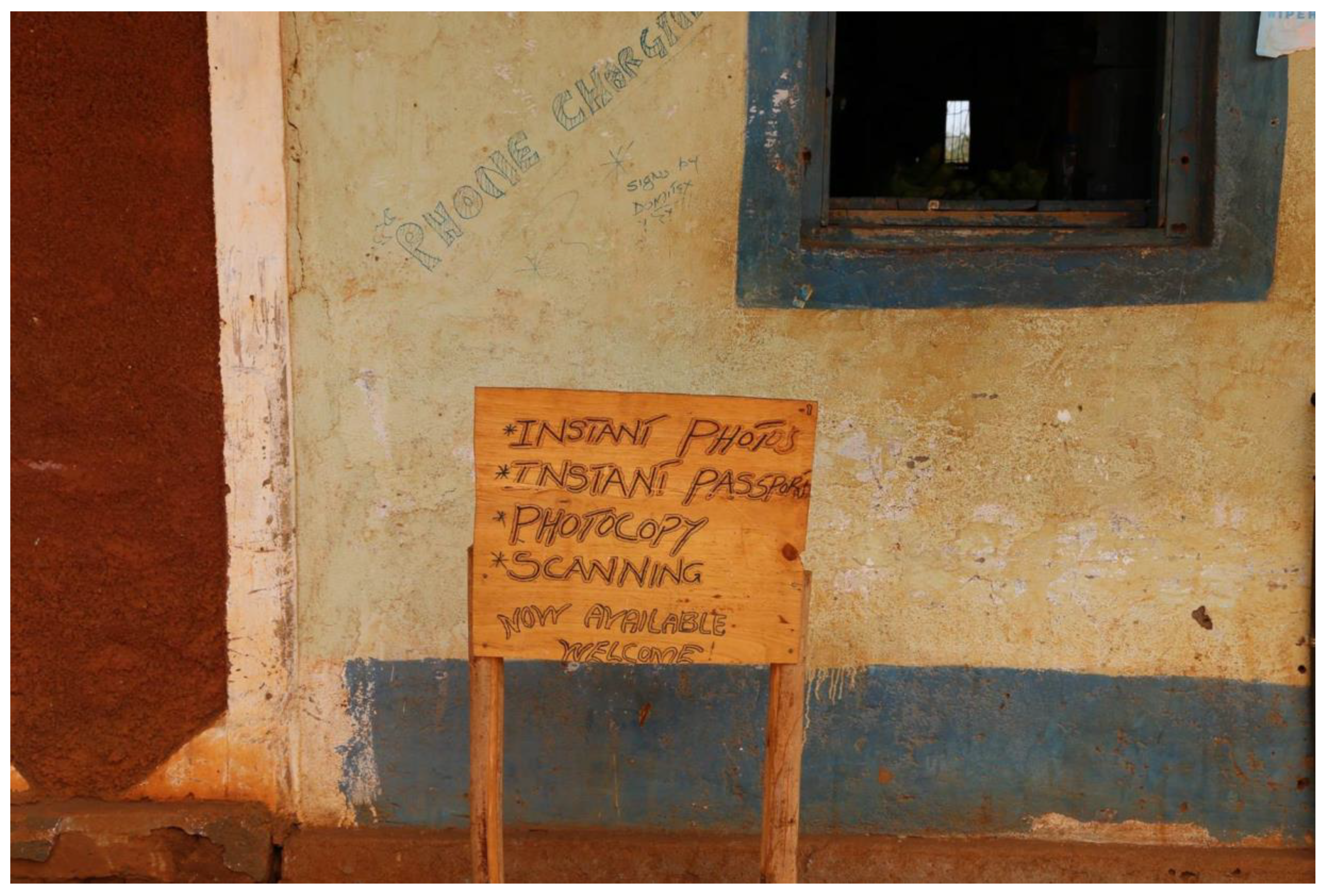
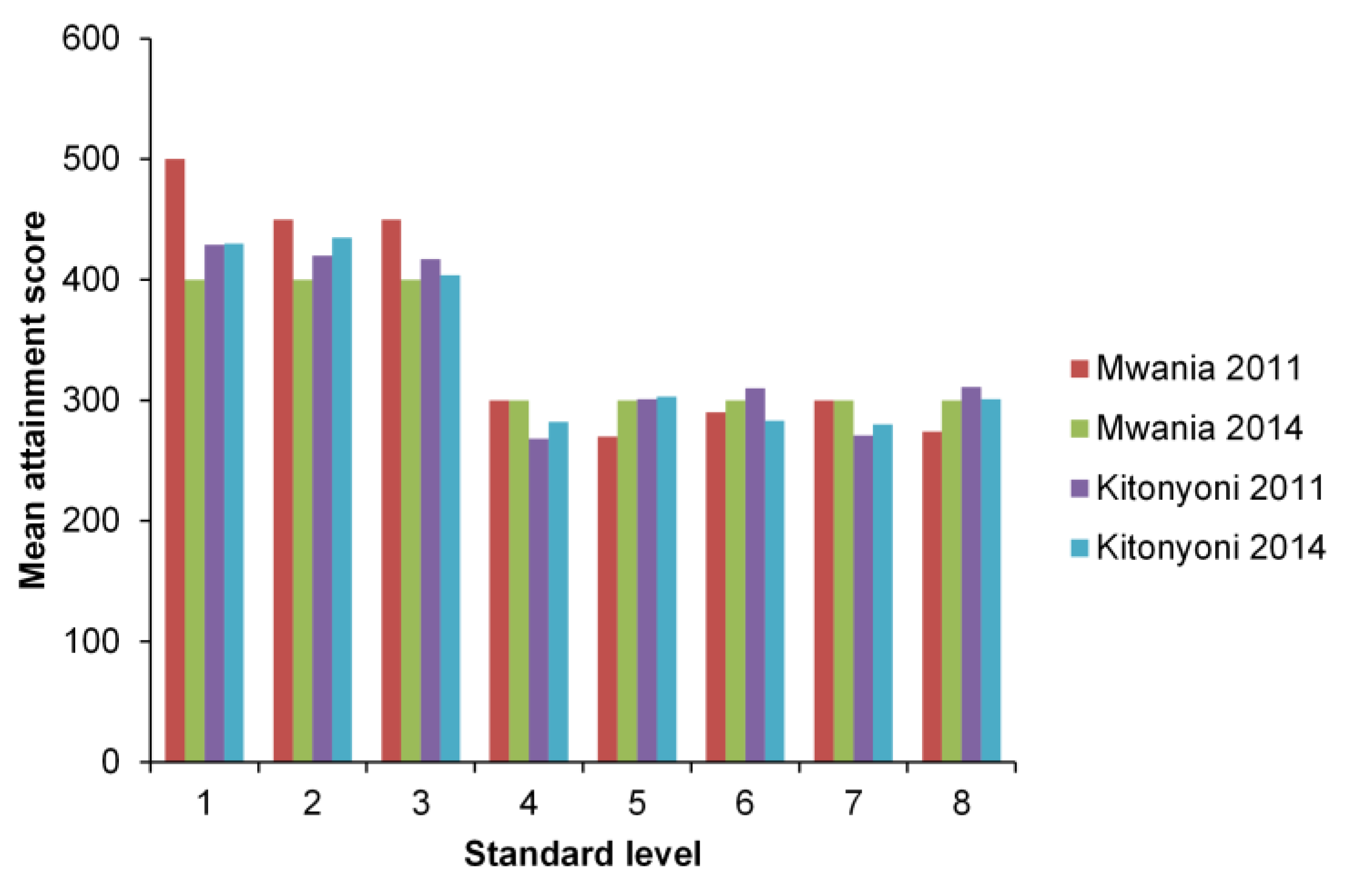

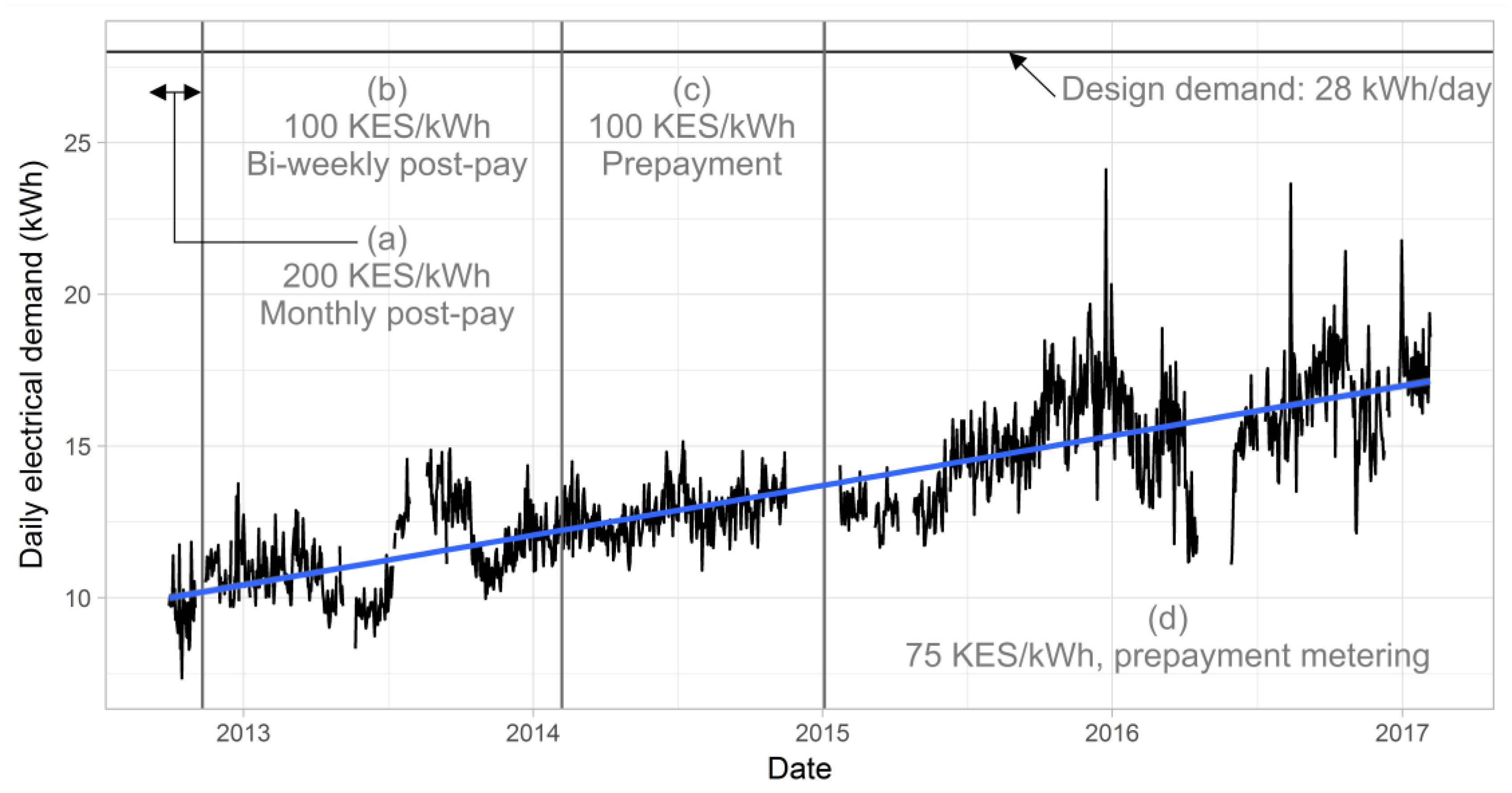
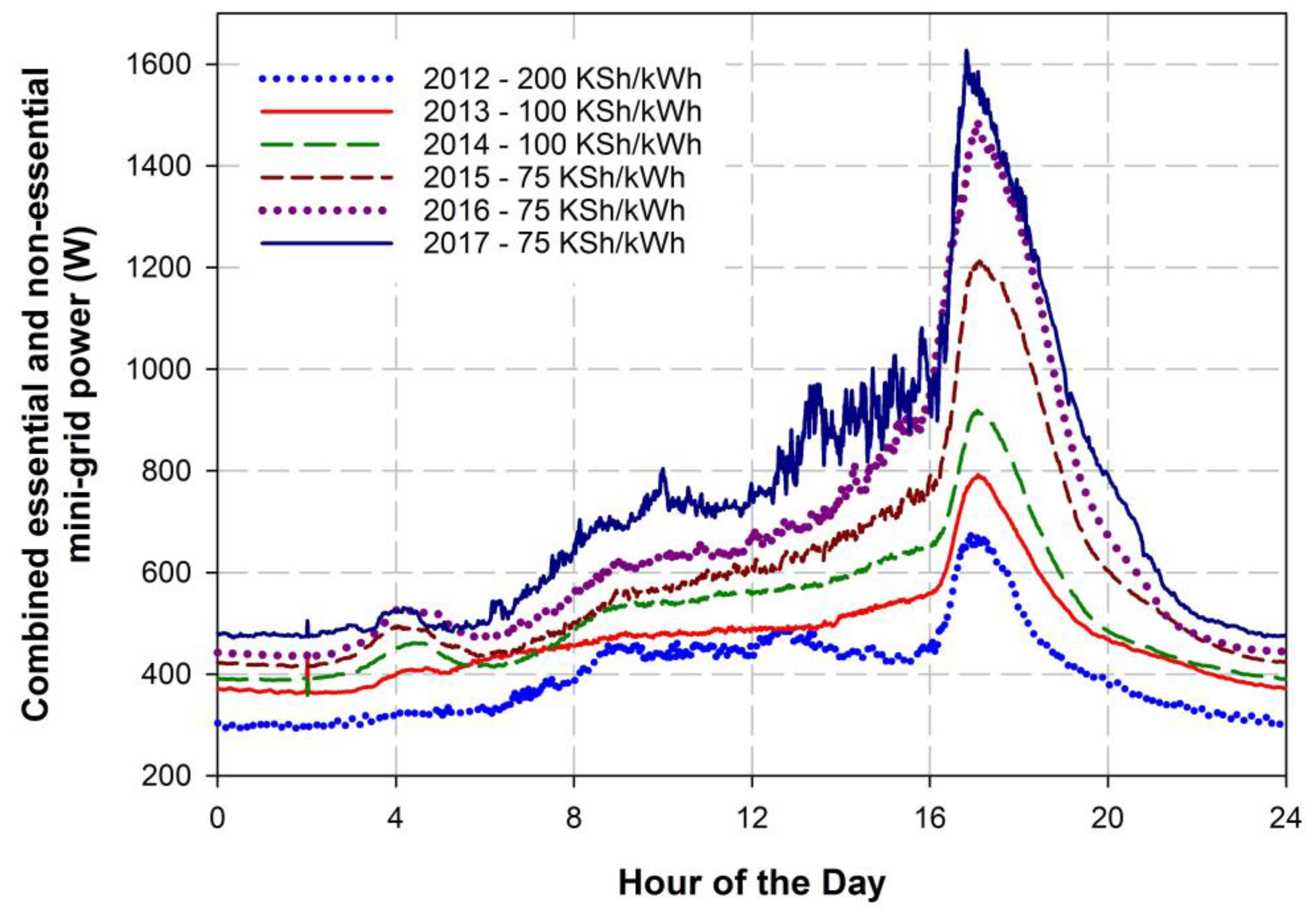
| Dependent Variable a | |||||
|---|---|---|---|---|---|
| ln(HH expenditure) | ln(paraffin exp.) | Step of wealth ladder | Pieces of fruit per day | Access to Electricity | |
| (OLS) | (OLS) | (OLS) | (OLS) | (linear probability OLS) | |
| Intervention group (0 or 1) | 0.012 | 0.135** | −0.313 *** | −0.018 | 0.082 ** |
| (−0.113, 0.137) | (0.026, 0.244) | (−0.539, −0.087) | (−0.100, 0.063) | (0.018, 0.145) | |
| Time (0 or 1) | 0.388 *** | 0.042 | 0.062 | 0.309*** | −0.012 |
| (0.267, 0.508) | (−0.061, 0.145) | (−0.156, 0.280) | (0.231, 0.387) | (−0.067, 0.043) | |
| Intervention: Time | −0.235 *** | −0.143 * | 0.526*** | 0.516*** | 0.334 *** |
| (−0.412, −0.058) | (−0.298, 0.011) | (0.206, 0.846) | (0.401, 0.631) | (0.217, 0.451) | |
| Constant | 8.398 *** | 5.328 *** | 3.753 *** | 0.113 *** | 0.316 *** |
| (8.312, 8.483) | (5.256, 5.401) | (3.599, 3.907) | (0.058, 0.169) | (0.273, 0.360) | |
| Observations | 1674 | 1250 | 1676 | 1678 | 1672 |
| R2 | 0.029 | 0.005 | 0.015 | 0.228 | 0.043 |
| Adjusted R2 | 0.028 | 0.003 | 0.013 | 0.227 | 0.042 |
| Residual Std. Error | 0.921 (df = 1670) | 0.692 (df = 1246) | 1.667 (df = 1672) | 0.599 (df = 1674) | 0.468 (df = 1668) |
| F Statistic | 16.882 *** (df = 3; 1670) | 2.085 (df = 3; 1246) | 8.316 *** (df = 3; 1672) | 165.201 *** (df = 3; 1674) | 25.226 *** (df = 3; 1668) |
| Case | Capital as Fraction of original | Project Lifetime (years) | Growth in daily demand in t years (kWh) | Tariff (KES) | Battery life (years) a | IRR (%) b | NPV with 5% Discount Rate (100,000 KES) b |
|---|---|---|---|---|---|---|---|
| As designed, predicted growth and tariff | 100% | 20 | min(7t, 28) | 200 | 10 | 13 | 94.6 |
| As designed, lower tariff | 100% | 20 | min(7t, 28) | 75 | 10 | 0 | (−50.0) |
| Actual demand and tariff | 100% | 20 | min(7.5 + 1.5t, 28) | 75 | 15 (expected) | (−2) | (−64.0) |
| As above, no canopy | 83% | 20 | min(7.5 + 1.5t, 28) | 75 | 15 (expected) | (−1) | (−47.0) |
| Aggressive cost reductions | 50% | 20 | min(7.5 + 1.5t, 28) | 75 | 15 (expected) | 3 | (−13.0) |
| As above, higher tariff | 50% | 20 | min(7.5 + 1.5t, 28) | 100 | 15 (expected) | 7 | 10.0 |
© 2019 by the authors. Licensee MDPI, Basel, Switzerland. This article is an open access article distributed under the terms and conditions of the Creative Commons Attribution (CC BY) license (http://creativecommons.org/licenses/by/4.0/).
Share and Cite
Bahaj, A.; Blunden, L.; Kanani, C.; James, P.; Kiva, I.; Matthews, Z.; Price, H.; Essendi, H.; Falkingham, J.; George, G. The Impact of an Electrical Mini-grid on the Development of a Rural Community in Kenya. Energies 2019, 12, 778. https://doi.org/10.3390/en12050778
Bahaj A, Blunden L, Kanani C, James P, Kiva I, Matthews Z, Price H, Essendi H, Falkingham J, George G. The Impact of an Electrical Mini-grid on the Development of a Rural Community in Kenya. Energies. 2019; 12(5):778. https://doi.org/10.3390/en12050778
Chicago/Turabian StyleBahaj, AbuBakr, Luke Blunden, Christopher Kanani, Patrick James, Isaac Kiva, Zoë Matthews, Heather Price, Hildah Essendi, Jane Falkingham, and Gerard George. 2019. "The Impact of an Electrical Mini-grid on the Development of a Rural Community in Kenya" Energies 12, no. 5: 778. https://doi.org/10.3390/en12050778
APA StyleBahaj, A., Blunden, L., Kanani, C., James, P., Kiva, I., Matthews, Z., Price, H., Essendi, H., Falkingham, J., & George, G. (2019). The Impact of an Electrical Mini-grid on the Development of a Rural Community in Kenya. Energies, 12(5), 778. https://doi.org/10.3390/en12050778







